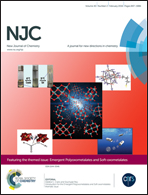Cross-linking of highly methoxylated pectin with copper: the specific anion influence†
Abstract
The aim of this work was to investigate the influence of specific anions on the cross-linking process of highly methoxylated pectin using the following copper salts CuSO4; Cu(C2H3O2)2; CuCl2; and Cu(NO3)2 wherein the initial salt concentrations were varied from 0.5 up to 10 g l−1. It was found that the anions affected the sorption capacity wherein the Cu2+ sorption capacity from the sulphate solution was the highest, while it decreased in the presence of CH3COO−, Cl− and NO3− ions, respectively. This difference was mostly pronounced at the higher initial salt concentrations (c0(Cu2+) > 2 g l−1). The obtained beads were characterized by FTIR, AAS, SEM/EDS microanalysis and mechanical compression tests up to 80% of deformation. The sorption data were applied to the Langmuir and Freundlich isotherm models and various calculated parameters confirmed the sulphate anion supportive nature in metal ion binding. The value of the Kf parameter for the cross-linking process of pectin in the presence of acetate, chloride and nitrate was approximately the same (Kf ≈ 0.027 g g−1), while it was higher in the presence of sulphate anions by more than 20% (Kf = 0.0352 g g−1). The predicted 1/n values (1/n < 1, 1/n > 1, 1/n = 1 for the sulphate, nitrate and acetate, and chloride anions, respectively) were the quantitative confirmation of the specific interactions involved in the cross-linking mechanism caused by different anions. The established anion influence was in accordance with the typical ion-specific influence on macromolecules in aqueous systems proposed by Hofmeister.


 Please wait while we load your content...
Please wait while we load your content...